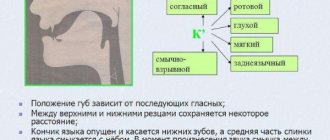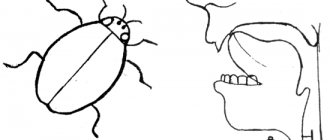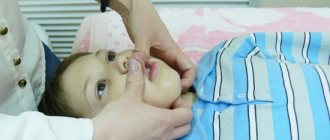Pronunciation of the T sound
We can highlight common mistakes made in the pronunciation of the T sound:
- replacing the sound T (it is front-lingual) with G and K (they are called back-lingual);
- mixing or rearranging consonants located next to the sound T (“rolled” instead of “glass”);
- after P or K, the T sound is lost and replaced with a softening (“piichka” instead of “birdie”);
- replacing the sounds Ch and C with T (“nine” instead of “girl”, “Petsya” instead of “Petya”).
Children who replace the T sound with some other sound often have incorrect articulation. The child raises his tongue to the palate, while the tip of the tongue should rest against the front teeth.
The reasons for incorrect pronunciation are as follows:
- malfunctions of the articulatory apparatus (speech organs);
- the lower jaw is weakly developed, which is why it is inactive during speech;
- the hearing organs are poorly developed, which is why the child cannot distinguish sounds by ear;
- imitating an adult who has problems with correct pronunciation.
Only a speech therapist can make a diagnosis. And parents, in turn, can practice at home the exercises recommended by a professional.
Do I need to contact a specialist?
If the sound “k” cannot be pronounced correctly by a child aged 4-5 years, then parents can try to teach how to pronounce it by organizing classes at home. It is very important to conduct them in a playful way. The child should be interested. You cannot force him, otherwise he will lose the desire to learn.
At the initial stage, classes are conducted by parents no more than 4-5 times a week for 10-15 minutes, then the frequency and duration of special exercises can be increased.
You need to practice in a convenient place, in front of a mirror, so that the baby can see the movements of his lips and have the opportunity to observe the facial expressions of mom or dad. The child should be praised for any success in pronouncing sounds.
If a problem with the pronunciation of the letter “k” is discovered in a child later, for example, at the age of 6-7 years, then he should be taken for a consultation with a speech therapist. A specialist will help you learn how to pronounce it as soon as possible so that the child does not have problems when studying at school.
You should also contact a speech therapist if classes are held for a long time, but do not bring results, the child cannot master the pronunciation of sounds. A professional will quickly find the reason why he cannot pronounce the sound “k” and give recommendations on how to eliminate it.
Articulatory gymnastics for the sound t
It is necessary to do articulation exercises daily. Get used to the fact that in any free time you and your baby develop the speech apparatus.
More on the topic:
- Articulatory gymnastics for the sound Ш
- Exercises for sounds “S, C, Z”
Setting the T sound
- Choose several syllables or words that contain the letter combination TA, and repeat them at least 10 times.
- Place the tongue between the teeth and press it firmly, but at the same time so that it does not hurt the baby, with the jaw. Take a deep breath and, as you exhale, say an interdental T.
- Place your tongue between your teeth again. Stretch your teeth in a smile and “spit.” After this, give your jaw a rest.
- T is a derivative sound from P. Therefore, you can start warming up by practicing the sound P. Say Pa-Pa several times, while the wide part of the tongue should be pressed to the lower lip. Gradually stretch your lips into a smile and move on to pronouncing Ta-Ta.
- Place the tongue between the teeth. Say Pa-Pa again several times. At this moment, the adult spreads the child’s lips with his index finger and thumb. When the manipulation is performed correctly, Ta-Ta is pronounced.
Speech therapy rhythms for children with speech disorders
Sound production
- Talk to the child Ta-Ta.
- A special paddle is used to soften the sound. Use it to press the tip of your tongue and lower it down. You should get the letter combination Tya.
- The sound Th is produced by clicking the tip of the tongue; the teeth should be closed at this time.
- You can complicate the exercise: do not press your tongue against the palate, but stick it out.
Examination and anamnesis
The cause of death, Dmitry Prokhorov, Ksenia’s husband, who took care of the affairs of his deceased father-in-law so as not to disturb his pregnant wife, was able to find out only after requests to the forensic medical examination bureau and the regional department of the Ministry of Internal Affairs.
From the bureau's response, it turned out that the original examination is issued only to those authorities that ordered it. In its response, the Ministry of Internal Affairs cited the expert's opinion - but without details. Dmitry was still able to watch the entire examination, but to do this he had to come to the department and read the report while standing, while several employees made sure that he did not photograph anything.
The forensic examination established that death was caused by cerebral edema as a result of a combination of encephalopathy and coronary heart disease against the background of hypertension.
“The examination says that death was caused by ischemic disease, but in the statement from the clinic where he was an hour before the vaccination, no ischemic changes were recorded, how can this be?” asks Dmitry. In addition, in the expert’s conclusion, according to Dmitry, there was not a word about vaccination that preceded death.
Death certificate of Oleg Konyaev
Dmitry tried to bring to justice the doctors of a private clinic who diagnosed Konyaev with intercostal neuralgia and did not notice any heart problems. He wrote requests to the Ministry of Health, Roszdravnadzor and the prosecutor's office. The Ministry of Health forwarded his appeal to Roszdravnadzor. They reported that there was no reason to inspect the clinic, and some questions could not be answered due to medical confidentiality.
Oleg Konyaev’s family believes that if the private clinic had recommended that he not get the second vaccination, and the clinic had paid more attention to his complaints, he would have remained alive.
“These are all links in one chain. At every stage it was possible to stop the process, but they didn’t stop it anywhere: first they didn’t make the correct diagnosis, and at the clinic they didn’t really examine me and didn’t ask anything, they did everything for show,” says Dmitry.
An independent cardiologist who looked at Konyaev’s ECG told Dozhd on condition of anonymity that he saw no critical signs that could alert him. He believes that in the private clinic the ECG was interpreted generally correctly.
Alexey Erlikh, a cardiologist at City Clinical Hospital No. 29, suggests that death could have been caused by a fatal disorder of cardiac rhythm, he adds.
According to Ehrlich, the cerebral edema indicated in the forensic examination in this case is not the direct cause of death - most likely, it is a phenomenon following circulatory arrest and acute cerebral ischemia.
Ksenia says that she had never heard about heart pain from her father before. According to her, he regularly underwent medical examinations at work. “But there, too, everything was fine with him, at most they told him to quit smoking,” she says.
In the end, Konyaev’s relatives were given an outpatient card at the clinic - after a request from Dozhd sent to the administration. There are few entries in it - a couple of visits to an ENT specialist and a surgeon. Both vaccinations are noted on the card, but no complaints were recorded before the second injection.
Record of the second vaccination in Oleg Konyaev’s outpatient card
Konyaev's family believes that vaccination became a catalyst for the processes that led to his death. “Seven hours [after vaccination] - and the person is gone. Is this a coincidence?” asks Dmitry.
An independent doctor whom Dozhd spoke with explains that in cardiology, everything often happens suddenly. “We have a lot of deaths from cardiovascular diseases and a lot of vaccinations are given, but as a consequence does not mean as a consequence,” he says.
Dmitry Prokhorov also sent documents about his father-in-law’s death to the European Medical Agency (EMA). There they were accepted and answered that they would consider them.
Speech therapy exercises
It is necessary to work on overall articulation and clarity of speech. For this, simple and interesting speech therapy complexes are used. We present one of these to your attention.
- “Brushing our teeth.” Stretch your lips in a smile, mouth slightly open. Use your tongue to walk alternately over the upper and lower teeth from the back side. Move from left to right and then in the opposite direction.
- "Spatula". Smile again with your mouth slightly open. Place the wide part of your tongue on your lower lip. Stay in this position for 10 seconds. You can start with 5 seconds.
- “Tube”. Extend your tongue as much as possible and tense it. Then, if possible, roll it up into a tube and stay in this position for 5-10 seconds.
- "Swing". Open your mouth slightly and press the wide part of your tongue against your lower teeth. Then raise your tongue to your upper teeth. We linger in each position for 2-3 seconds. In this case, you need to press with maximum force.
- "Slide". Starting position – mouth slightly open. Press the tip of your tongue firmly against the bottom row of teeth. Then, without lifting the tip, press with the wide part of your tongue (it should bend as if). Stay in this position for 5 seconds.
- "Mountain Wind" Place your tongue in the position described in the previous exercise and blow as hard as possible. In this case, the entire speech apparatus should be tense.
How to teach a child to say the letter “K”?
If you decide to study with your child at home, then parents should master the methods of pronouncing the sound “k”, make a selection of special speech therapy games and exercises that will help teach him to pronounce this letter.
Before conducting classes teaching your child correct literary pronunciation (spelling), you should perform several general speech therapy exercises to warm up the speech apparatus. The most effective are:
- "Tube". The child should extend his lips forward with a tube and hold in this position for 5 seconds.
- "Smile". The baby should be asked to smile as wide as possible, but not show his teeth.
- "Snake". The child should be asked to stick his tongue out and in between tightly compressed lips 5 to 7 times.
- "Fence". The son or daughter should smile, showing the lower and upper teeth.
- “Brushing our teeth.” The child opens his mouth as wide as possible and runs his tongue along the inside of the upper teeth, then the lower ones, first from left to right, and then vice versa.
Articulation gymnastics is carried out for 10 minutes. With its help, you can prepare the speaking muscles of the face to perform games and exercises aimed at mastering the sound “k”.
Methods for making the sound “k”
The sound “k” belongs to the group of back-lingual sounds. To pronounce it, you need a high rise at the root of the tongue. Children often skip these sounds or replace them with easier-to-pronounce front-lingual ones. If we exclude pathologies due to which the baby cannot pronounce the letter “k,” then we can say that the child’s tongue is lazy to work at full capacity.
If the child is unable to speak the letter “k”, the child replaces it with the letter “t” (“tofta” instead of “jacket”, “tapitan” instead of “captain”, “Tatya” instead of “Katya”, etc.). In some situations, it is enough for parents to clearly pronounce the sound a couple of times so that the child sees their facial expressions and can repeat it. But not all children immediately grasp the correct pronunciation.
One of the methods for teaching how to pronounce the letter “k” is a mechanical technique. The parent invites the son or daughter to pronounce the syllables “ta-ta-ta” several times. While he does this, mom or dad presses the tip of the tongue down and moves it slightly back. You can perform the manipulation using your finger or the handle of a teaspoon.
The tongue moves back, presses against the palate, and gradually takes the position necessary for a clear pronunciation of the sound “k”. It is enough to repeat the technique several times, then the baby begins to pronounce the letter without outside help.
Consolidating the sound “k” in a child’s speech
After the baby learns to pronounce the letter “k” on his own, parents should pronounce with him every day as many words as possible in which it is used. Tongue twisters (“The pussy has soft paws”, “We bought a cuckoo hood”, “Dwarf Karl was tumbling on the carpet”, “Klava put a bow on the shelf”, etc.), proverbs or poems are also suitable for this purpose.
Games and exercises
To teach your child to pronounce the letter “k”, you should do the following exercises with him:
- "Slide downhill." The child is taught to hold his tongue in a slide position. Then a cotton ball is placed on his palm. Next, the baby should keep the root of the tongue slightly raised, while lowering its tip. After completing the steps described above, the child should exhale air, blowing the ball off his palm. When performing this exercise, the sound “k” should be heard. Not all children are able to pronounce it the first time.
- "The language is a fighter." One of the parents and son or daughter sit in front of the mirror. The child should be told that his tongue turns into a fighter who will have to fight with an enemy (mom or dad's index finger). The baby begins to smile with his mouth open as wide as possible, and at this time the adult rests his finger on the tip of his tongue, pushing it back a little. The child tries to push the finger out of the mouth. The parent finger then moves to the front wall of the tongue, pressing lightly on it. Eventually, the baby's tongue will take the "slide" position necessary for the correct pronunciation of the "k" sound. Next, the child will be able to put his tongue in the correct position without struggling with the adult’s finger. When performing this exercise, parents should be extremely careful not to scratch the baby's mouth with their nails or cause a gag reflex. Hands must be washed clean.
5 recommendations for parents
Conducting speech classes gives results, but in addition to them, parents should play games with their baby that promote the development of fine motor skills.
Why do you need to develop fine motor skills and what are the benefits of it? This article will tell you.
Mom or dad can sort through cereals or pasta with him, teach the child to string beads on a thread or fishing line, and sculpt figures from plasticine or salt dough.
- Speech therapists and speech pathologists also recommend that parents:
- Ask the baby to repeat the sound if he pronounced it successfully.
- When a child has learned to say a letter, its pronunciation is reinforced by pronouncing phrases, syllables and words with it.
- Mom or dad can invite the child to remember words with the sound “k” on his own, name pictures from a book where it is present.
- A child should not be forced to study if he does not want to or does not feel well.
- If there is no result from studying at home, the child is shown to a speech therapist or defectologist.
Setting the sound t when replacing with k
- First you need to teach your baby to distinguish between these two sounds. To do this, you can give pictures, the images in which begin with the sounds T or K, and also pronounce such words out loud. Ask the child to distribute into groups (K and T).
- Game “Catch the Sound”. The adult pronounces a small series of letter combinations, and the child must clap his hands when he hears the given sound.
- We are looking for the sound K. Dar-ra-ko-so. Sa-lo-ku-we. Am-da-ka-he ku-ro-lo-ky
- We are looking for the sound T. Ba-ta-do. Na-la-to. Ash-bo-ot. Ju-fu-fu.
Formation of coherent speech in children with general speech underdevelopment
Opaque system
The developers of the Russian vaccine do not comment on the death of patients. To the request of Rain in the center named after. Gamaleya was advised to contact the Ministry of Health, from where the Dozhd correspondent was again redirected to the Moscow Department of Health.
There are reports of deaths after vaccination in other countries, but vaccine manufacturers are responding to them very differently. On July 15, The Mercury News from California published the story of 60-year-old Tim Zook, who died four days after his second shot with the Pfizer vaccine for heart failure. An autopsy revealed a focus of severe coronary heart disease.
The death of Tim Zook, as the publication writes, was entered into the government system where all the consequences of vaccinations are recorded. This system is open - anyone can obtain data from it; the American regulator (CDC) only warns that one must approach their analysis with caution.
The CDC website updates vaccination data regularly. The latest summary, dated July 13, said there have been 6,079 (0.0018%) reported deaths among the more than 334 million vaccine doses administered to people in the United States. In the vast majority of studies, no connection was established between vaccination and death.
Immediately after the death of Tim Zook, Pfizer offered condolences to the relatives of the deceased. “Serious consequences, including deaths unrelated to vaccination, will unfortunately occur [among those vaccinated] at the same rate as they occur in the population,” a spokesperson commented. Dozhd's interlocutor believes that data on the consequences of vaccinations is being hidden deliberately - but at the same time notes that it is still necessary to get vaccinated.
The EUObserver publication also notes the opacity of Russian vaccination data and suggests that the four deaths that became known in April may not be the only ones.
Setting the t sound for dysarthria
At the very beginning, you need to pay attention to warming up the tongue and removing tone, as well as general gymnastics for the speech apparatus. For this purpose, the speech therapy exercises listed above are used.
- Raise and lower your tongue, turn right and left. In this case, the tongue is extended as much as possible.
- Then the adult invites the child to tap his tongue on the upper palate (the sound should be T).
- To obtain a soft consonant, the tongue is pressed harder against the palate and moves out more between the teeth. At the same time, the passage for air is reduced.
- To practice the T sound, it is pronounced between two vowels (at least 10 repetitions).
- The baby must cluck at least 20 times. After this, the task becomes more complicated: you need to click while exhaling, not while inhaling.
- The child is asked to place his palm on his larynx. After this, pronounce the sounds T and D. Focus on the difference in vibrations during the pronunciation of the sounds T and D.
No connection established
A few months earlier, the European Agency had already received information about deaths after vaccination with the Russian drug. In April, the English-language publication EUObserver published material based on internal reports from Rospotrebnadzor, which were provided to the EMA by an anonymous Russian source.
These reports documented four deaths following Sputnik V vaccination. Three of the deceased were identified - they turned out to be two women from the Leningrad region and one from the Perm region. The authenticity of one of the reports was confirmed to the publication by virologist Denis Logunov, deputy director of the center. Gamaleya, who developed the vaccine.
IN
about the death of a woman from the Perm region, coronary disease was indicated as a preliminary diagnosis - just like Konyaev. The woman died a day and a half after vaccination. Her case was included in departmental reports, but Konyaev’s death remained outside the system.
Theoretically, doctors are required to transmit data on any post-vaccination complications to Roszdravnadzor, an agency that also controls the circulation of drugs. This information, as follows from the department’s response to Dozhd’s request, goes into a special database called “Pharmacovigilance 2.0.”
Konyaev’s death, as Roszdravnadzor reported in response to Dozhd’s request, is not reflected in this database. As Rain found out, the Moscow Department of Health considered that the case was not related to vaccination. In response to Dozhd’s request about Konyaev’s death, the Department of Health said that it was informed about this case, but “the examination did not find a cause-and-effect relationship between vaccination and death.” The specialist who conducted the forensic examination gained access to all of Konyaev’s medical documents, according to the department, and “the fact of vaccination at the time of the analysis was reflected in the patient’s electronic record and was taken into account during the examination.”
According to the Department of Health, Konyaev was diagnosed with “manifestations of long-term chronic cardiovascular diseases, such as coronary heart disease, hypertension, the complications of which led to sudden death.” These diseases, the department emphasizes, “beyond exacerbation are not a contraindication for vaccination and cannot worsen as a result of vaccination.”
At the same time, in the forensic medical examination, which Konyaev’s son-in-law Dmitry was able to read at the Ministry of Internal Affairs, vaccination, according to him, was not mentioned at all. The Department of Health claims that the vaccination was not reflected because “the study did not reveal any complications after the vaccination.”
Oleg Konyaev. Photo: family archive









